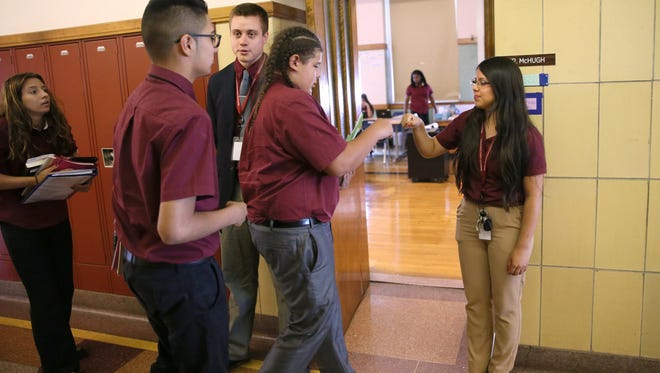Borsuk: The bright spots in Milwaukee's school scene don't mask weak links

The best high school in Wisconsin? According to the U.S. News and World Report rankings, released several days ago, it is the Carmen High School of Science and Technology campus on Milwaukee’s south side. Which is a charter school.
One of the most disheartening and alarming developments on Milwaukee’s school scene this academic year? The closings of three Universal Academy for the College Bound schools, right in the middle of the school year and in fashions that raise a lot of questions. And they were charter schools.
I have trouble talking about the charter school “sector” in Milwaukee. I don’t think there is one. I think there are more than two dozen charter schools that offer the best and the worst of what is happening in local education. They don’t really operate as a unified group.
There must be lessons in this. Perhaps these are some of them:
Schools should be viewed one by one. There’s so much attention focused on how Milwaukee Public Schools is doing, or how voucher or charter schools are doing. But success levels are all over the place within each sector and quality is much better viewed as a school-by-school subject. (By the way, the Hmong American Peace Academy, HAPA, on the northwest side was the second highest rated high school in Wisconsin, in the view of U.S. News. It, too, is a charter school. The MPS press release announcing the high ratings of Carmen and HAPA didn’t include the word “charter,” which is still an ugly term to some within MPS and in the teachers union, since the schools don’t use teachers who are MPS employees.)
RELATED: Carmen-Pulaski co-location shows promise
RELATED: Universal Academy to scale back charter presence
Leadership is crucial. What do Carmen and HAPA and other top schools in each sector in Milwaukee have in common? Excellent leaders. And you can’t ignore leadership issues at the many schools that have failed in recent years.
The Business and Economics Academy of Milwaukee, also a charter school, is closing at the end of this school year after more than a decade of ups and downs. Falling enrollment and money pressures are big reasons. But Linda Robinson-Prodoehl, president of the BEAM board, told me last week that one lesson she had learned is “the job of principal or school leader is huge.” To its credit, BEAM is closing in an orderly way, unlike the abrupt mid-year closings of the Universal schools.
Enrollment is crucial. Getting parents to pick your school is an intensely competitive matter across Milwaukee. Parents have so many choices. To thrive, a school needs not only full enrollment but a student body that will have a reasonable degree of stability and the potential for creating a good culture in a school. That also speaks to good recruiting.
Universal opened in two closed MPS schools in 2013 and expanded to a third. This appears to have been a mistake. Not that the leaders have been available to answer questions, but the schools ended up with too few students, the organization seems to have lost a lot of money, resources became scarce in the schools, and operations became unstable (especially at the last school to go, in the old MPS Webster school on the north side).
Money is a big issue. Ask pretty much anyone involved in leadership in any school or set of schools and they’ll say they need more money. As the state budget enters its decisive phase, think about this. Is every dollar used well? No. But are we giving education enough fuel to succeed, especially in high-needs places? Are all these school people wrong?
Outsiders don’t understand us. The track record of charter schools created and grown in Milwaukee is pretty good and has some genuinely bright spots. With some exceptions, the track record for schools that are based elsewhere has been weak. Universal is based in Philadelphia. Lighthouse, which had a high-profile closing in Milwaukee last year, operates in several states and clearly didn’t get Milwaukee. There are others. Are we difficult? Or do too many out-of-town education entrepreneurs fail to learn the turf? (A side question: Can Rocketship schools beat the trend? They’re trying hard.)
MPS is re-creating its past in the name of creating its future. This is so interesting and deserves more attention than I can give it here. Several of the failed charter schools were in buildings MPS closed years ago when they had low enrollment and weak results. Now MPS is re-opening some of those buildings (Green Bay Avenue, Webster, and Andrew Douglas, to name three) with their old names. And a few years ago, MPS merged Morse Middle School and Marshall High School. Now the two are separated and live again under their old names.
It’s all so confusing. No one from MPS was available to talk with me about all this during the last 10 days, but let me raise two questions: What’s going to be different now, after all these prior closings? How much are these re-openings about keeping kids enrolled under the MPS umbrella and keeping MPS buildings from becoming private schools?
The bad news can seem overwhelming. The good news is that there is good news.
Carmen got a green light from the Milwaukee School Board in March to open a middle school on the south side in fall of 2018. It will be Carmen’s fourth school in the city. There are efforts underway to build up other high-performing schools in town.
But we aren’t going to get ahead in a big way unless we candidly confront and do something about the bad news, including why we have so many schools (and, more importantly, children) whose lives are unstable and too negative, and why we have so much unproductive jockeying between schools and streams of schools.
Alan J. Borsuk issenior fellow in law and public policy at Marquette Law School. Reach him at alan.borsuk@marquette.edu.
